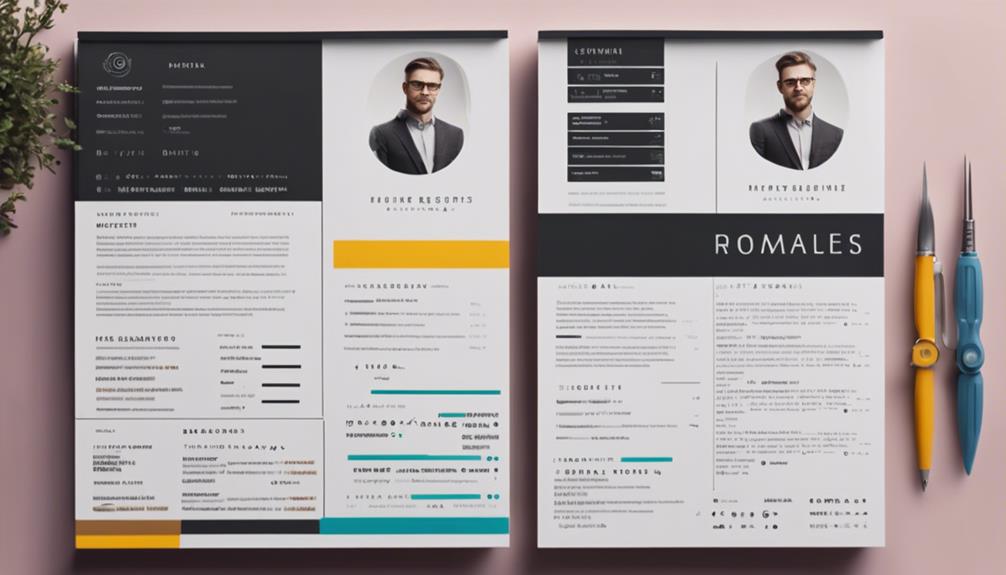Varied resumes are your key to opening the door to your dream job. By tailoring your resume to different roles, you highlight relevant skills and experiences that match specific job requirements. Explore different formats like chronological, functional, or combinations to showcase your unique background. Don't forget creative approaches, such as infographic resumes, to stand out in competitive fields. Regularly update your resume with new skills and accomplishments to keep it fresh and relevant. With the right strategies and tools, you'll enhance your chances of catching an employer's eye. There's much more to discover that can boost your job search.
Key Takeaways
- Tailor your resume format—chronological, functional, or targeted—to best showcase your skills and experiences for each job application.
- Incorporate relevant keywords from job descriptions to enhance compatibility with Applicant Tracking Systems (ATS) and increase visibility.
- Utilize creative resume formats, like infographic or digital portfolios, to stand out in competitive job markets and reflect personal branding.
- Regularly update your resume to include new skills and experiences, ensuring it accurately represents your qualifications and career growth.
The Role of Resumes
Resumes act as your personal marketing tool, connecting you with potential employers and showcasing your professional journey. A well-crafted resume provides a concise snapshot of your skills, experiences, and accomplishments, making it easier for hiring managers to see your value.
To stand out, you need to tailor your resume for each job application, aligning it with specific requirements and using relevant keywords to pass Applicant Tracking Systems (ATS). Start with a compelling summary or objective that captures attention.
Remember to use complete sentences in bullet points for clarity. Regularly revising your resume guarantees it remains current and effective in highlighting what makes you the right candidate for your desired position.
Exploring Resume Types
Choosing the right resume type can greatly impact how you present your skills and experiences to potential employers. Knowing the various types helps you tailor your resume effectively. Here's a quick overview:
| Resume Type | Best For | Key Feature |
|---|---|---|
| Chronological | Steady career path | Lists work history by date |
| Functional | Gaps in employment | Focuses on skills over experience |
| Combination | Diverse experiences or career changes | Merges skills and work history |
| Targeted | Specific job applications | Aligns closely with job postings |
| Infographic | Creative industries | Uses visuals to present skills |
Each type serves a different purpose, so choose wisely to enhance your chances of landing that dream job!
Understanding Detailed Formats

Explore the detailed formats of resumes to understand how each can effectively highlight your skills and experiences.
A chronological resume lists your work history in reverse order, making it perfect if you have a steady career path.
If you've faced employment gaps or are switching careers, consider a functional resume that emphasizes your skills instead of your job history.
The combination resume merges both styles, showcasing your achievements first and then detailing your work history.
Each format serves a unique purpose, so choose one that aligns best with your background and the job you're targeting.
Tailoring your resume format can greatly impact how employers perceive your qualifications, increasing your chances of landing that dream job.
Creative Resume Approaches
Innovative resume approaches can greatly enhance your visibility in a competitive job market.
Think about using an infographic resume, which combines visuals and concise text to present your skills and achievements creatively. This format can grab attention and showcase your design sense, especially in creative fields.
Alternatively, consider a non-traditional resume, like a video or digital portfolio, to demonstrate your personality and skills dynamically. Just make sure these formats are compatible with Applicant Tracking Systems (ATS) to avoid being filtered out.
Tailoring your resume to the specific job and industry can also considerably increase your chances. By stepping outside conventional formats, you'll not only stand out but also reflect your unique brand.
Key Tips for Writing

To craft an effective resume, focus on showcasing your most relevant experiences and skills tailored to the specific job you're targeting.
Start with a strong summary or objective that captures attention.
Use bullet points for clarity, guaranteeing each point is a complete sentence that highlights your achievements.
Prioritize the most significant roles and responsibilities that align with the job description.
Include a dedicated skills section, clearly listing both hard and soft skills to give hiring managers a quick overview of your qualifications.
Remember to revise your resume for each application, incorporating keywords from the job posting.
Tools for Resume Success
Utilizing the right tools can greatly enhance your resume writing process and help you stand out in a competitive job market. Here are three essential tools you should consider:
- Resume Builders: These online platforms provide templates and step-by-step guidance, making it easy to create a polished resume without starting from scratch.
- Keyword Analyzers: Use tools that help identify industry-specific keywords to guarantee your resume gets past Applicant Tracking Systems (ATS) and resonates with hiring managers.
- Editing Software: Grammar and spell-check tools can help you refine your language, guaranteeing clarity and professionalism.
Importance of Continuous Updates

Regularly updating your resume guarantees it accurately reflects your evolving skills and experiences, making you more appealing to potential employers.
As you gain new qualifications or take on different responsibilities, it's vital to document these changes. This practice not only keeps your resume fresh but also makes certain that you highlight the most relevant accomplishments for each job application.
Additionally, revisiting your resume allows you to refine your presentation and tailor it to match specific job requirements.
Remember, a compelling resume is a living document; it should grow alongside your career.
Frequently Asked Questions
How Long Should My Resume Be for Optimal Impact?
Your resume should generally be one page for most job seekers. If you have extensive experience, two pages can be acceptable. Keep it concise and focused on relevant information to maximize impact.
Should I Include Unpaid Work or Internships on My Resume?
Yes, you should include unpaid work or internships on your resume. They demonstrate relevant experience, skills, and commitment. Just make certain they align with the job you're applying for to enhance your candidacy effectively.
How Do I Handle Employment Gaps in My Resume?
"Where there's a will, there's a way." To handle employment gaps, emphasize skills gained during that time, use a functional format, and briefly explain circumstances if necessary. Focus on what you can contribute now.
What Are the Best Fonts to Use for Resumes?
When choosing fonts for your resume, stick to professional options like Arial, Calibri, or Times New Roman. These fonts enhance readability, maintain a clean look, and guarantee your resume stands out for the right reasons.
Can I Submit the Same Resume for Multiple Job Applications?
Submitting the same resume for several job applications isn't smart. Each position deserves a tailored touch, showcasing relevant skills. Customizing your resume enhances your appeal and increases your chances of landing an interview.
Conclusion
In today's competitive job market, your resume is your first chance to make a lasting impression.
Think of Sarah, who landed her dream job after transforming her standard resume into a visually engaging infographic. By embracing resume variety and tailoring her approach, she showcased her creativity and skills, catching the eye of her future employer.
Remember, every detail matters, so keep refining your resume and let it tell your unique story.
Your dream job is just a polished resume away!









